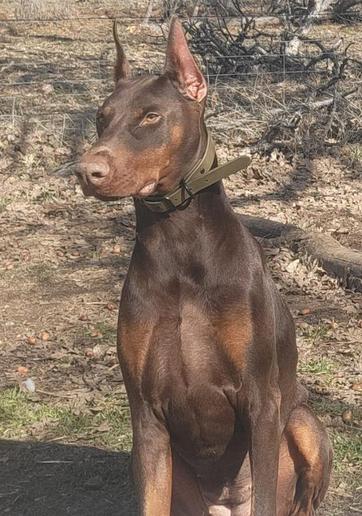DanBar Ranch
von Willebrand Disease (vWD)
vWD is the most common type of bleeding disorder found in dogs, with Dobermans being one of the most commonly affected, though it has been identified in 54 breeds since 1970.
While there are three types of vWD only type 1 - the least serious - accounts for 95% of all canine cases and is characterized by a partial deficiency in vWF, which causes a mild-to-moderate bleeding risk. It is rarely life threatening.
Genetically, a Doberman can have one of three status of vWD. If they inherit NO mutated genes, they will "CLEAR" and at no risk of having or passing on the disease. If they inherit ONE mutated gene they are called a "CARRIER" and at no risk of having the disease and have a 50% chance of passing on ONE mutated gene when bred. Bred to a CLEAR dog they will produce both "CLEAR" and "CARRIER" pups, but no AFFECTED pups.
When a dog has TWO mutated genes they are called "AFFECTED" and can possibly show signs of the disease. Again, the amount of bleeding is not often significant, however if dogs can be produced without risk of the disease, all the better.
If an AFFECTED dog is bred to a CLEAR dog 50% of the litter will be CLEAR and 50% will be CARRIERS. If an AFFECTED dog is bred to a CARRIER 50% of the litter will be carriers and 50% will be AFFECTED. If an AFFECTED is bred to an AFFECTED dog, 100% of the litter will be AFFECTED.
* J Vet Diagn Invest. 2018 Mar; 30(2): 310–314.
DanBar Ranch Policy on Breeding "Carriers" (vWD)
THE DOBERMAN BREEDER'S DILEMA:
Every serious, dedicated, long term dog breeder must make very important decisions each and every pairing of dogs.
The reason? No dog is perfect - each dog taken up for consideration as a breeding dog will have several faults to work around.
These can be mental/character faults, structural faults or health faults. ALL are important. ALL must be considered and WEIGHED against one another.
A great breeding program is based on trying not to match up two dogs with the same fault and trying to REMOVE faults from the line of dogs through selective breeding.
In a perfect world we would always match up as many positives and as few negative traits as possible. But do all ALL faults carry the same weight? They do not.
PUBLIC ENEMY NUMBER ONE!
At this time the there are two co-equal challenges facing the Doberman. The lack of correct "Doberman temperament" (i.e. shy or dull dogs) and the disease "Cardiomyopathy". The first kills the breed, the second kills the dog. Both must be addressed at the expense of lesser faults until such time they are not THE primary destroyer of our breed.
The Doberman today is the Poster Child for everything that is wrong with modern dog breeding practices, human ego and greed, the indifference of puppy buyers to educate themselves and the lack of educational efforts by Doberman breed clubs and the American Kennel Club.
Von Willebrand Disease Type I, (vWD) is very common in the Doberman. Research papers quote a prevalence of the disease at 50% in the United Kingdom and 73% in the United States.
Luckily it does NOT manifest as a serious issue in most Dobermans. (There are three levels of the disease and Dobermans have the lowest). The worst I have ever seen it manifest is just a slight reduction in blood clotting time. Nothing that interferes with the cropping of ears or docking of tails.
For this reason there is justification for breeding a Doberman who is a genetic "carrier" or even in some cases, an "affected" for vWD - IF THEY HAVE OUTSTANDING HEART HEALTH and other positives. A pup sold with vWD will NOT DIE OF THE DISEASE - but a pup sold with DCM risk most probably will.
HOW TO ELIMINATE vWD WHILE STILL USING CARRIERS AND AFFECTED DOGS
IN A BREEDING PROGRAM
Obviously an ethical breeder would prefer to never use a dog with ANY genetic risks! But with such a high percentage of dogs being carriers or affected, there will come a time when a breeder may have to weigh up the pros and cons of using a carrier or affected dog of otherwise tremendous quality and health. I faced this dilemma with my two Czech import dogs Lancer and Maulie. They have it all; amazing longevity in their background, perfect heart health, fantastic working pedigrees, above average structure for working line dogs and great character.
As a breeder I cannot just thrown their genetics away due to each having one gene for vWD - however... I CAN STOP THE SPREAD OF vWD ANY FURTHER. And this I do. I wish other breeder's would do the same for in a short time we could eradicate the disease from the breed.
I accomplish this delicate balance by this one simple step: NO DOG THAT IS NOT COMPLETELY CLEAR OF vWD GENES LEAVES MY KENNEL AS A "BREEDING DOG". In other words, the buck stops here.
The very rare occasion one of my pups would test as a vWD "carrier" or "affected" I can place the dog with confidence knowing it will lead a healthy life, but it will always be sold with "Limited Registration" so that it cannot be used for breeding.
In this way I am able to produce outstanding, healthy Dobermans AND do my part to eliminate vWD in the breed. As always when buying a puppy from me there will be FULL DISCLOSER about health and you will be given copies of all health testing associated with the pup and it's parents and grandparents. If you have any questions about this please don't hesitate to contact me.



